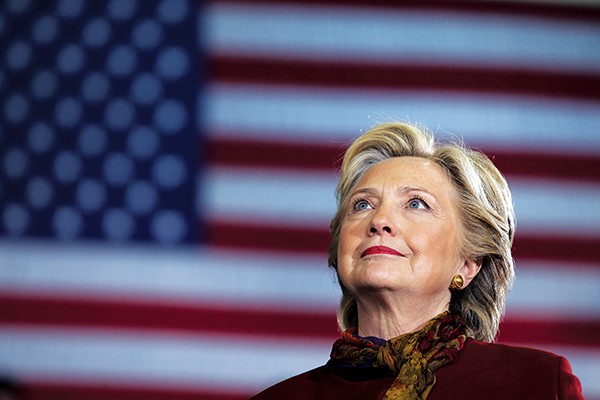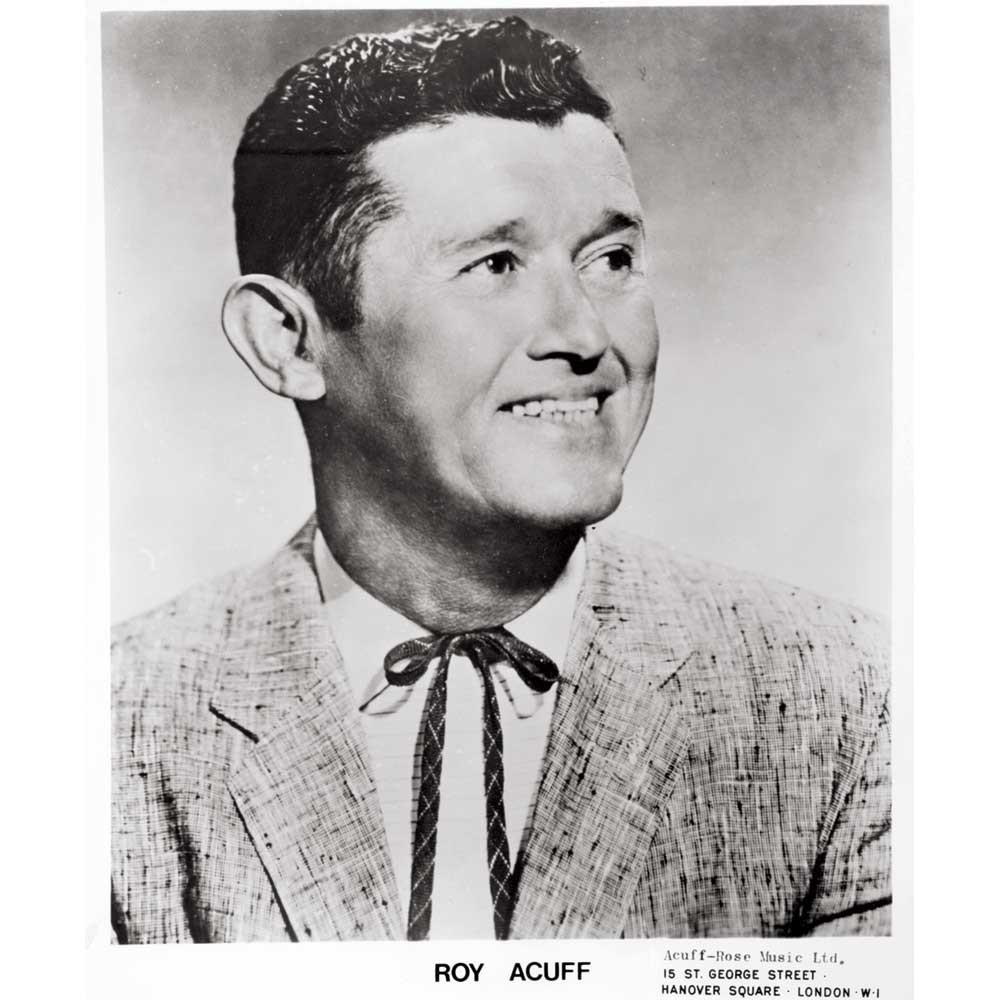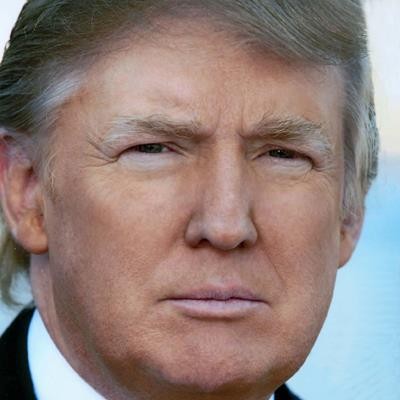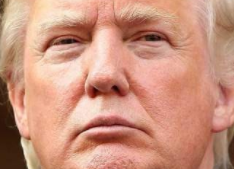Donald Trump has become the president-elect of the United States, in a “change election” that few pollsters or pundits saw coming.
Though the first returns from the key battleground state of Florida were ambivalent, auguring a tight contest between Democrat Clinton and Republican Trump, the GOP nominee finally pulled away decisively in the race for that state’s 29 electoral votes. Trump would eventually also win Ohio and and North Carolina, the latter of which had been regarded as a toss-up. Even Virginia, which seemed destined to end up blue in the end, in Clinton’s column, had teetered in Trump’s direction for much of the evening.
More ominously for Clinton, not only Michigan, site of last-minute Hail Mary efforts by Trump, but the neighboring Midwestern state of Wisconsin, which had been regarded as safe for the Democratic nominee, were tilting toward Trump. Then, in the early hours of Wednesday, the “blue wall” of northern Midwest states came crumbling down, as Trump won Pennsylvania, Michigan, and Wisconsin. The bottom line was that Trump was everywhere doing better than expected and against all advance odds, had a clear sight-path toward an upset win.
Amid reports that election-day voting in key states had been robust (like previous totals in those states with early voting), CNN’s first exit poll, of voters at large in the nation, came in just after 4 p.m., CST. Omitting specific mention of either candidate, the poll demonstrated that those persons surveyed leaned toward rewarding experience as against change and that 88 percent of them had made their choices before the last week — before, that is, Trump’s prospects had briefly spiked because of the FBI’s now-you-see-it, now-you-don’t renewal of its inquiry into Clinton’s use of a private email server as secretary of state.
Both findings had seemed to be good omens for the former secretary, and so, for that matter, was the professed indifference of those polled to whether their chosen candidate emanated a sense of empathy with voters. At no point during the long campaign was that considered one of Clinton’s strong suits —nor Trump’s for that matter, though the size and boisterousness of his campaign crowds attested to his undeniable magnetism on the stump.
It was an odd contest, one between two candidates who had survived their primary elimination contests despite each having record high undesirable ratings in various polls. Neither of the two best-known “third party” candidates, Libertarian Gary Johnson or the Green Party’s Jill Stein, had been able to wean away significant numbers of voters from the two major-party nominees, Clinton and Trump. Theirs was the contest that counted.
 Reuters | Carlos Barria
Reuters | Carlos Barria
Hillary Clinton
One half of the final pairing — Democrat Clinton — was more or less inevitable from the start, given the continued existence of an extensive political network devoted to her and to the fairly sizeable Clinton circle at large; given the fact of residual public yearning to crack the still-intact glass ceiling excluding women from the nation’s ultimate office; given her continued prominence and professional service as secretary of state (and the dutiful deference she showed in the process to Obama, who had conquered her in the act of smashing a long-standing ceiling of his own).
And given, finally and perhaps most importantly, the fact of an undiminished, perhaps even amplified personal ambition that was already extraordinarily large.
That she came in for an unexpectedly intense and long-lasting primary challenge from Senator Bernie Sanders of Vermont may, in those circumstances, have seemed a bizarre quirk of fate to some. A Jewish septuagenarian and professed socialist? An official independent? C’mon, man! What kinda script is that?
Yet, what the scoffers and disbelievers missed was the simple fact that Sanders, who had certain inspiring avuncular qualities as well, was determined to destroy an even more formidable and enduring ceiling than Obama and Hillary Clinton had confronted — that which protected monolithic capital wealth from assault and ensured, to one degree or another, that there would always be an economic inequality that was systemic and intractable.
There should have been no surprise that a legion of idealistic young voters, joined by long-of-tooth survivors of various prior lefty causes and their up-to-the-minute counterparts would rise to Sanders’ standard — especially since Hillary had so clearly cozied up to the bastions of big money, both for pragmatic and, it would seem, ideological reasons.
She was a reformer of sorts, an undoubtedly sincere exponent of diversity in all its forms — by race, by gender, by sexual orientation, what-have-you. Her critics on the left conceded as much, but they saw her mission to be that of redistributing the usual proceeds, the limited remnants of opportunity that the have-nots could, with luck, lay claim to in a stratified economy.
The ongoing squeeze of the middle class, the static nature of wages, the widening income gap, and the loss of manufacturing jobs to low-wage workers in free-trade partner nations — all this gave legs to the Sanders campaign and eventually forced Clinton to move enough in the direction of his issues to supplement her pre-existing political advantages.
One of the myths of the Democratic race was that Clinton was the practical thinker and Sanders the romantic, but trade was an area where her equal-opportunity “open-borders” rhetoric worked to the advantage of other nations, while Sanders’ protectionist instincts on the issue may actually have been more hard-nosed and realistic.
On the other side of the political fence, Trump began his competition for the Republican nomination against 16 rivals who had more or less identical positions in favor of free trade, tax cuts, a confrontational foreign policy, diminished federal regulation, recycled supply-side economics, law-and-order, etc. — all the cookie-cutter items in the GOP playbook. That these particular cookies had grown stale and unappetizing — crumbs on the table for those whom loser Mitt Romney in 2012 had stigmatized as the 47 percent — was something his opponents missed.
Their catechism was not his. Indeed, it can probably be said that he had — and has — no fixed principles. Notoriously, Trump seemed indifferent to issues per se, and was even uninformed about them and willfully so, which is one reason — along with his TV celebrity and made-for-media persona — why his performance in the organized Republican debates inevitably turned on crowd-pleasing scorn and personal insults applied to his rivals. They could not match him in this regard, and when, like Florida Senator Marco Rubio (“Little Marco,” as Trump dubbed him), they tried to, their rate of descent into irrelevance was actually sped up.
This is not to say that Trump could not comprehend and adopt — even believe in — specific political positions. Through most of his highly public career as a New York playboy and mega-rich developer, he had been a typical Manhattanite: pro-choice, for example, and, while clearly owning a sense of male sexual entitlement, undisturbed by the vagaries of sexual orientation. As late as the early years of this decade, he was a professed admirer of the Clintons, Bill and Hillary both. Indeed, they kept social company.
A political warning sign was Trump’s advocacy in 2011 and 2012 of the “birther” nonsense (i.e., the notion that Barack Obama had been born in Kenya, not the U.S.A., and, therefore, was ineligible to be holding his office of president. It manifested Trump’s willingness, for better or for worse, to wander way off the beaten path (in this case, inarguably for the worse).
But consider some of Trump’s un-Republican heresies of the 2015-16 election season: He was as prone as Bernie Sanders (and more so by far than Hillary Clinton) to attack Wall Street; he was Bernie-like again in his vehement denunciation of free trade deals; he was probably within his rights to insist that he had opposed George W. Bush’s Iraq war (his supposed assent to the war in a 2012 interview with Howard Stern was a tentative thing — a grudging acquiescence to a point-blank question and one that he would repudiate in short order).
He surely deserves props for a kind of forthrightness or chutzpah (pick one) in having accused Bush of lying to get us into war during one of those televised set-to’s with other Republicans. And, in his acceptance address at Cleveland this past summer, Trump made a point of sounding out every initial loud and clear as he promised to uphold the rights of the nation’s LGBTQ community.
For all that, Trump was the loosest of pistols, self-indulgent and undisciplined, and the campaign would find him firing one loud blank after another in frustration and in defiance of successive campaign teams that tried to get him on message, any message. The one he finally absorbed, under pressure, was uninspiringly close to the GOP boilerplate — tax breaks for the wealthy, death to Obamacare, hiking up the military — that he had scoffed at to begin with. In the process, he compromised his opportunity to build upon the white, working-class, largely male constituency he had managed to galvanize.
So it was that, in the late stages of the presidential campaign, two wounded candidates focused their bids for the Presidency on personal attacks against each other on two matters as paradoxically revealing as they were irrelevant to the larger issues.
Clinton went after Trump for his reprehensible and genuinely shameful attitudes and actions vis-à-vis women — all suddenly and conveniently on public view in the weeks before the election.
Trump attacked Clinton in the most vicious way on the subject of her admittedly fast-and-loose use of a private email server while serving as secretary of state, finally adopting the “Lock Her Up” mantra of his crowds that he had only winked at in the cacophony of his Cleveland convention.
For whatever reason (and both sides at various times had their suspicions) FBI Director James Comey played Emily Litella on a Bureau investigation of the case — raising doubts about Clinton, then dismissing them, then raising them and going “Never mind” again, all in rapid succession.
Ordinary inertia would have brought the polling curve of the two campaigns closer together toward the end — especially as each had remarkably high, and similar, unpopularity ratings, but Comey’s actions had the effect of slowing Hillary’s apparent victory parade and accelerating the evening-out process.
In the last week of the campaign, the nation’s political pundits, who had come to sound like repetitious myna birds in the face of what had begun to look like a Hillary runaway, found their voices again with the reappearance of what looked passably like a neck-and-neck drama.
Another factor that lent a renewed semblance of suspense to the proceedings was the “homecoming” effect that normally occurs as presidential campaigns approach their conclusion: Third-party pretenders began to lose their steam, and lukewarm cadres of the two major parties came back to home base in a show of unity behind nominees about whom they may have harbored serious doubts previously.
In 2016, both Clinton and Trump benefited from the effects of this inevitable last look. A contributing factor was the realization on each side that, as got repeated from time to time during the campaign, “down-ballot” races for the House of Representatives and, especially, the Senate were at stake in the presidential outcome. Even more importantly, given the gridlock that had virtually shut down Congress as a functioning institution, was the fact that the next president would have the opportunity to appoint anywhere from one to four new Justices to the Supreme Court, the one arena of American government where dynamic social change could still occur.
Lost in all the ad hominem fuss of the presidential campaign was a whole panoply of legitimate issues, ranging from the economic inequality that Sanders had managed to highlight to what may have been the most urgent — and most ignored — issue of all, the question of global warming. Indeed, the neglected problem of climate change remains the foremost of several lingering questions that the new President and the new Congress will have to puzzle out solutions to. Others include:
Syria: The vicious, multi-sided war rages on in that devastated land, with no solution in mind, either about ending the conflict itself or in dealing with the stream of refugees.
Immigration: Beyond the theatrical dilemma of wall-or-no-wall remains the simple question: Is this a real, enduring problem? Or did the alleged flood from Mexico really begin to resolve itself way back with the bursting of the housing balloon that lured so many would-be workers across the border?
Health care: All right, as Bill Clinton (somewhat indiscreetly for his side) noted, Obamacare has some flaws. So what gets done to improve or replace it: Something or nothing?
The income gap: It really is there. Are we going to address it now? Or will we obscure it again with another full set of red herrings?
The Russians: Now that the election is over and we have a winner, can we acknowledge that Vladimir Putin, who is neither a Republican nor a Democrat, interfered with our elective system in cahoots with Wikileaks and needs to be held to account? For that matter, what do we do about his continual destabilizing presence in the Middle East or his unrelenting pressure on his western border?
Trade: There would likely have been no Donald Trump (and there may have been no Bernie Sanders) but for the unavoidable reality of the nation’s changing trade relationship to numerous upstart nations, with China and India forecast as the most significant long-term rivals.
Energy: There is still the urgency of finding environmentally sustainable means to replace polluting fossil-fuel sources. And anybody who thinks nuclear energy is the answer needs to go Google such formerly well-known terms as “the China syndrome” and “Three Mile Island.”
Race relations, terrorism, and law enforcement: To understand why these concepts belong together, just reflect on the Catch-22 whereby reasonable concerns have arisen about the over-militarization of local police while, at the same time, the threat of terrorist strikes argues for an enhanced ability for para-military response.
A final thought: If there is a bright side on the American political scene, it is the falling-away of various social issues as sources of discontent. Though they still try, it is increasingly harder for politicians to play bait-and-switch with the electorate, promising to do all they can to uphold certain long-cherished “values” while ignoring those promises in office and pursuing private economic agendas instead. The fact of change in the social sphere — in everything from Hillary Clinton’s pantsuits to the unchallenged acceptance of LGBT citizens in positions of public responsibility — is unmistakable and probably irreversible.
Now, it’s time: Strike up a chorus of “Hail to the Chief.” And cross your fingers.

 Submitted Photo
Submitted Photo 

 Reuters | Carlos Barria
Reuters | Carlos Barria  Breezy Lucia
Breezy Lucia 


